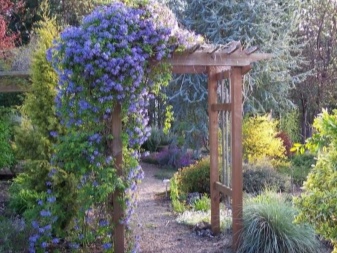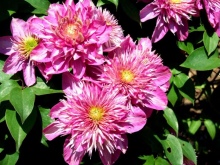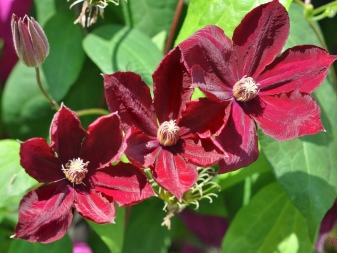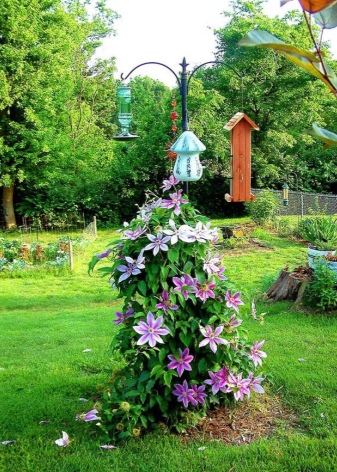Clematis in landscape design

Clematis is a vine-like plant with unusually bright and beautiful flowers. The unpretentious and showy culture blooms almost all season, and green and succulent leaves and ornamental seeds adorn it until winter.


The most beautiful species and varieties
Clematis feels great on any soil except waterlogged. Prefers sunny places, but also tolerates partial shade. It is unpretentious and does not need special care. For the winter, it requires pruning and insulation.
Clematis differ in the shape of the bush, the timing of flowering, the size of the inflorescences and the color.
The catalog contains over 2 thousand such plants. There are modest representatives with dull colors, as well as species that are striking in decorativeness and color. Often varietal clematis have a pleasant smell that attracts insects.


The shape of the bush is distinguished:
- herbaceous perennials: for flower beds, lawns, pond or patio edging;
- semi-shrubs: for decorating terraces, curbs, low fences;
- shrubs: planted near fences and in a front garden with other species;
- lianas: braiding arbors, walls, fences.



By the type and structure of flowers there are:
- standard - petals in one row;
- semi-double - two or three rows;
- terry - more than three rows.



Most of the ornamental varieties are hybrids obtained with the participation of various clematis species. Each is assigned by origin to a specific group. For example, Zhakman's group was obtained with the participation of Zhakman clematis, and the Florida group - flowering clematis.


Zhakman
It grows up to 4 meters, has a developed root system. The flowers are blue, purple, purple, up to 20 cm. The buds are single or 3-4 on the peduncle. Without smell.
- Rouge Cardinal. Prefers sun and soil with good drainage. Climbs over the supports. Blooms from June to August.


- Purpurea. An unpretentious liana for the front garden, it grows in flowerpots on the balcony and veranda.


- "Blue flame". Loves well-lit places, blooms twice a season: in May and in September. Hardy and unpretentious, but in cold winters it needs shelter.


Florida
Liana grows up to 3 meters. The flowering time depends on the variety. The colors are white, greenish and ivory, pink, lilac. Flowers up to 12 cm, different in shape and number of petals.
- Siebold's variety. Suitable for growing in the garden and in containers. Container plants hibernate at temperatures from 0 to +5. The variety needs good pruning and shelter in winter. Blooms from June to September.


- Alba Plenta. The flowering period is from June to September. Low frost resistance. It grows well in containers that are transferred in winter to rooms with temperatures from 0 to +5.


- "Bride". Differs in a fragrant aroma. Blooms from May to September. Loves the sun with partial shade. Resistant to disease and cold.
Almost no pruning is required.


Viticella
Shrub vine reaches three meters in length. Differs in large flowers. The color ranges from light pink to burgundy.
- Etoile Violette. A frost-resistant hybrid that can withstand up to -20 degrees, but needs shelter. Blooms from June to September. Considerable pruning is required in the fall. Loves regular watering.


- Polish Spirit. Feels good in partial shade and in the open sun. Blooms from June to October. Frost resistant. Tolerates mild drought, but prefers abundant watering. In the fall, it needs full pruning.


Patens
Re-blooming: first bloom in May-June, second - towards the end of summer.Inflorescences of various shapes, sizes, colors: white, pink, lilac, blue, purple. There are simple inflorescences and terry, monochromatic and with a strip on the petals.
- First Lady. Blooms in May on last year's shoots, blooms on this year's shoots from August to October. Winter hardy. Little pruning is required.


- Multi Blue variety. Can be grown on the balcony as the plant is small and grows well in containers. Shoots grow up to 2 meters. It blooms during the warm season.


- Nelly Moser variety. Climbing plant, grows up to 3.5 m. Buds are formed both on last year's and on new shoots. It tolerates frost well.


Integrifolia
Shrub up to 1.5 m. Small flowers: white, blue, lilac, pink. Usually presented in the form of bells or stars. The plant tolerates severe winters well. Does not like waterlogging of the soil.
- "Alyonushka". Height up to 2 meters, but support is required for thin and flexible shoots. Blooms from early May to September. Pruning in the spring. Shade-tolerant, but excess moisture in the soil is contraindicated. Frost resistant.


- Blue River cultivar. Blooms from June to September. The bush does not cling to the supports, but needs a garter. Can grow in containers. Frost resistant.


Lanuginose
Liana reaches 2.5 m. Spring flowering occurs on last year's shoots, and begins on new ones in July-August. Lilac or white inflorescences have 6 to 8 petals ranging in size from 10 to 20 cm.
- Valge Daam. Liana requires significant pruning. Does not like excess moisture. Blooms profusely from July to the onset of cold weather. Can be grown in containers.


- "Ballerina". It reaches a height of 3 meters.
Before wintering, cut and cover.


Small-flowered
These are shrub vines. The difference is considered to be small flowers up to 5 cm. They are unpretentious, only shoots of this year are covered with buds. The flowers are white, lilac, purple, honey-colored. They give off a very pleasant aroma.
- Clematis hot. A strong vine with lush greenery and small flowers. One shoot can have up to 400 buds. Pleasant honey-almond aroma.


- Clematis Manchu. Originally from the southeast of Russia, found in China and Japan. Impervious to frost, grows well in open places. Old shoots are removed in the fall. The flowers are fragrant. Suitable for creating a green hedge.


Combination with other colors
By combining different varieties and types of clematis, you can achieve interesting design options for your backyard territory. Clematis in combination with other plants create unusual compositions in landscape design.
Clematis gets along well with climbing crops: nasturtium, ivy, honeysuckle, hops, wild or fruit grapes. Wood vines are best combined with clematis, which almost do not require pruning, and annuals can be planted with plants that are pruned more than half in the fall.


The rose company is perfect for clematis. An English courtyard is traditionally created by combining these two types. The solid woody stems of the roses support the delicate clematis vines. The conditions of maintenance and care are so similar that the plants do not experience discomfort from such a neighborhood. Rose bushes are ideally combined with clematis integrifolia. For climbing options, the Jacquemann or Viticella subspecies will be the most successful choice.
Clematis shoots grow faster than rose whips. Therefore, it is recommended to plant it first, and as the bush gets stronger, it is supplemented with a small liana-shaped form of clematis. For decoration, monochromatic or contrasting color options are selected. Clematis roots prefer shade, for this purpose it is recommended to plant lawn grass or flowers with shallow roots nearby: calendula, petunia, nasturtium, marigolds, geraniums, irises, phlox.


Vines grow well with hydrangea, buddlea. Shrub burning clematis - with black elderberry, fragrant acacia, barberry. Low semi-shrub species - with lilacs, rose hips, jasmine. Coniferous species look good with different types of clematis, a liana, launched along the trunk of a spruce or pine, looks neat.
An elegant combination will also be with a low-growing juniper or thuja.


Where to plant?
For planting, choose a sunny site. Some hybrids can grow and bloom in partial shade, but at least 6 o'clock in the afternoon sun is still needed. The soil requires fertile, moist, well-drained, neutral or slightly alkaline. Clay and damp with a close location of groundwater is not suitable. You will also need protection from the wind, as sharp gusts can break vines and flowers.


The decorative properties of the plant are perfect for decorating a suburban area:
- a single support entwined with a clematis looks very beautiful;
- an arch or a gazebo, twined in a semicircle with a flowering plant, create a unique romantic look in the garden;
- in the country, where there is no place for growing trees and shrubs, clematis will create the necessary shade;
- lush foliage with abundant flowering in the summer will close the wall opposite the window or fence, unaesthetic buildings;
- clematis planted along the fence create good sound insulation;
- a liana near a summer cottage or veranda will become additional protection from the scorching sun, and dense greenery and bright flowers will be an object of admiration;
- plants on a special lattice and a frame pyramid look unusual.



The vertical vine has several disadvantages:
- dense and dense foliage of the plant creates conditions for the appearance of dampness; this type of landscaping is not suitable for the northern wall;
- closing the windows, clematis strongly shades the room;
- climbing onto the roof, plants can ruin the gutter.
Clematis is used on alpine slides, rocky grottoes, gnarled trees, flower beds and lawns. Blooming ground cover species creeping in a carpet create unusual compositional solutions. In decorative vases and containers, they will help to decorate a terrace, veranda and even a balcony. Species that bloom at different times, when grown together, create a decorative appearance throughout the summer and autumn.



Correct care
When choosing a place for clematis, one must take into account that overgrown shoots can shade part of the garden. Better to choose a location on the south or east side. Planted in spring. In a group - at a distance of half a meter, single plants - one and a half meters, retreating half a meter from the fence.
These plants are resistant to many diseases, but their root system is the most vulnerable. It is important in the summer season to keep the lower part of the clematis in the shade, not to dry it out. And at the same time, excessive waterlogging can cause the appearance of fungus. To avoid this, it is necessary to carry out treatment with special preparations. Roots and shoots need shelter from frost for the winter.


Mulching with humus will protect the roots and become a breeding ground for the next season.
A flowering plant needs weekly abundant watering and regular feeding: 5-8 times per season. Mineral fertilizers are applied in the fall to the loosened soil. Regular pruning is essential for growth, development and abundant flowering. Correct pruning will help form a vine and a bush, and aesthetically decorate a corner of the garden. Varietal clematis are pruned to varying degrees of intensity.


For the correct removal of shoots, it is necessary to find out the degree of pruning of the variety.
There are three trim groups:
- first (A) - this includes plants that bloom in the spring on the shoots of last year;
- second (B) - spring flowers appear on last year's shoots, and summer ones - on new ones;
- third (C) - flowers appear in the summer only on the shoots of this year.


Plants of the first group are slightly pruned in the fall to a height of 1-1.5 meters. In the second group, pruning is done twice a season: after the first flowering, and then in the fall. The third group requires strong pruning in the fall, leaving about 30 cm from the root with several buds.
The duration of flowering can be regulated by pruning the strongest shoots: the flowers on them will bloom later, and the rest will have time to bloom by this time. With proper care, clematis can bloom for twenty years.


Interesting examples
- Arch of clematis


- Clematis on the trunk


- Combined with a climbing rose


- Green alley

- Liana on the canopy


- Decoration of outbuildings


- Balcony options


- Clematis with conifers


- Clematis on the hedge


- In the decoration of the patio


- On the wall of the house










































































































The comment was sent successfully.